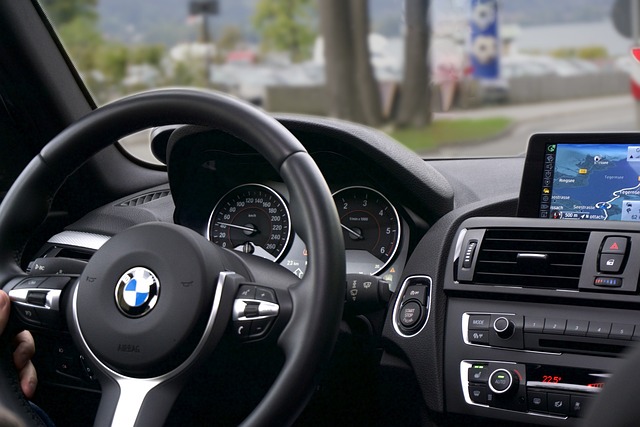Looking to register your car in California? This comprehensive guide breaks down the process step-by-step. From understanding eligibility requirements for car registration in California to gathering necessary documents for DMV VIN verification, preparing for vehicle inspection and title transfer, completing the registration process, and choosing between online or in-person registration—we’ve got you covered. Master the art of car registration with these essential tips and ensure a smooth transition.
- Understand Eligibility Requirements for Car Registration in California
- Gather Necessary Documents for DMV VIN Verification
- Prepare Your Vehicle for Inspection and Title Transfer
- Complete the DMV Registration Process and Pay Fees
- Register Your Vehicle Online or In-Person: Which Method Is Best?
Understand Eligibility Requirements for Car Registration in California

Before you begin the registration process, it’s crucial to understand the eligibility requirements for car registration in California. To register your vehicle, your car must meet specific criteria set by the Department of Motor Vehicles (DMV). One key step is ensuring that the Vehicle Identification Number (VIN) verification is accurate and matches the make, model, and year of your vehicle. This process typically involves a mobile vin verifier or vin inspection to cross-reference the VIN with the manufacturer’s records.
Additionally, your car must be in safe operating condition, have up-to-date safety features, and comply with emission standards set by the state. It’s also important to have all necessary documentation, including proof of ownership, liability insurance, and a valid driver’s license. With these requirements met, you can streamline the registration process at your local DMV office or through their online services.
Gather Necessary Documents for DMV VIN Verification

Before heading to the California DMV for registration, ensure you have all the required documents ready for a seamless dmv vin verification process. This includes your vehicle’s registration certificate from the previous state, proof of insurance, and a valid driver’s license. Additionally, gather important papers related to ownership, such as a purchase agreement or bill of sale.
For a faster mobile vin inspection or vin inspection, some states allow you to make an appointment beforehand. Check with your local DMV if they offer this service, which can save you time and effort. Having these documents prepared will not only streamline the registration process but also ensure that your vehicle’s information is accurately verified during the dmv vin verification.
Prepare Your Vehicle for Inspection and Title Transfer

Before you can register your car in California, ensure your vehicle is ready for the inspection process. This includes ensuring all necessary documents are up-to-date and readily available. You’ll need proof of ownership, typically a certificate of sale or previous registration, along with valid identification like a driver’s license. Additionally, you must obtain a Vehicle Identification Number (VIN) verification from the DMV, which can be efficiently completed through a mobile vin inspection service.
Prepare your vehicle by ensuring it meets all safety and emission standards set by the state. This might involve checking lights, brakes, tires, and other critical components. Some services even offer on-site or mobile vin verifier options, allowing you to streamline the process further. Make sure your VIN is accurate and legible, as this information will be crucial during the inspection and title transfer stages.
Complete the DMV Registration Process and Pay Fees

After gathering all the necessary documents and information, it’s time to complete the DMV registration process. Visit your nearest California DMV office or use their online services to initiate the registration. You’ll need to provide details like your personal information, vehicle specifications, and proof of insurance. Ensure you have accurate data regarding your car’s make, model, year, and Vehicle Identification Number (VIN) for a smooth process. The VIN is a unique code that can be quickly verified by using a mobile vin verification service or even a simple online tool to ensure all the information matches.
During registration, you’ll also need to pay relevant fees. These may include vehicle registration costs, title transfer charges if applicable, and possibly an emissions testing fee. You can opt for various payment methods, and some DMV locations might offer mobile vin inspection services to simplify the process further. Keep your receipt handy as it serves as proof of registration and payment.
Register Your Vehicle Online or In-Person: Which Method Is Best?

Registering a car in California can be a straightforward process, whether you choose to do it online or in-person. Both methods have their advantages, but understanding which one suits your needs is essential. Online registration offers convenience and speed, allowing you to complete the process from the comfort of your home. You’ll need to provide your vehicle’s details, including its make, model, year, and the current odometer reading. Additionally, a DMV (Department of Motor Vehicles) VIN verification is crucial during this step, ensuring that the vehicle matches the information on record. This process involves checking the vehicle identification number (VIN) against the state’s database to confirm its authenticity.
On the other hand, in-person registration provides an opportunity for immediate feedback and clarification. It’s ideal for those who prefer face-to-face interaction or have complex matters requiring resolution. When registering at a DMV office, you’ll still need to undergo a VIN inspection, but it’s conducted by a representative who can guide you through the process. Consider using a mobile vin verifier for convenience; this service allows for remote verification of your vehicle’s history and VIN, which can be a time-saver before or after visiting the DMV.
In California, registering your car involves several steps, from understanding eligibility requirements to completing the DMV vin verification process. By gathering the necessary documents, preparing your vehicle for inspection and title transfer, and choosing between online or in-person registration, you can ensure a smooth process. Remember, proper registration is not just about compliance; it protects your investment and ensures safe, legal operation on California’s roads.
